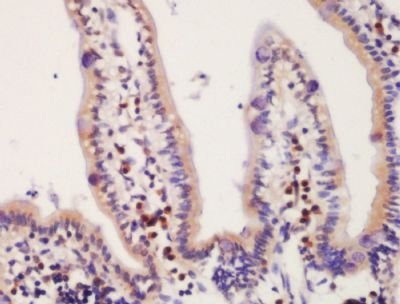产品货号 : mlR12436
英文名称 : HIC5
中文名称 : 转化生长因子β1诱导转录因子1抗体
别 名 : Androgen receptor coactivator 55 kDa protein; Androgen receptor coactivator ARA55; Androgen receptor-associated protein of 55 kDa; ARA55; Hic-5; Hydrogen peroxide-inducible clone 5 protein; TGFB1I1; TGFI1_HUMAN; Transforming growth factor beta 1 induced transcript 1; Transforming growth factor beta-1-induced transcript 1 protein; TSC 5.
研究领域 : 细胞生物 染色质和核信号 信号转导 干细胞 转录调节因子 表观遗传学
抗体来源 : Rabbit
克隆类型 : Polyclonal
交叉反应 : Human, Mouse, Rat, Chicken, Dog, Cow, Horse, Rabbit, Sheep,
产品应用 : ELISA=1:500-1000 IHC-P=1:400-800 IHC-F=1:400-800 ICC=1:100-500 IF=1:100-500 (石蜡切片需做抗原修复)
not yet tested in other applications.
optimal dilutions/concentrations should be determined by the end user.
分 子 量 : 50kDa
细胞定位 : 细胞核 细胞浆 细胞膜
性 状 : Lyophilized or Liquid
浓 度 : 1mg/ml
免 疫 原 : KLH conjugated synthetic peptide derived from human TGFB1I1/HIC5:31-130/461
亚 型 : IgG
纯化方法 : affinity purified by Protein A
储 存 液 : 0.01M TBS(pH7.4) with 1% BSA, 0.03% Proclin300 and 50% Glycerol.
保存条件 : Store at -20 °C for one year. Avoid repeated freeze/thaw cycles. The lyophilized antibody is stable at room temperature for at least one month and for greater than a year when kept at -20°C. When reconstituted in sterile pH 7.4 0.01M PBS or diluent of antibody the antibody is stable for at least two weeks at 2-4 °C.
PubMed : PubMed
产品介绍 : Hic-5 contains four LIM motifs and seven zinc finger domains. In the cell, Hic-5 localizes to the nuclear matrix and focal adhesion complexes where the LIM domains mediate the interactions of Hic-5 with focal adhesions. Known also as transforming factor beta 1 induced transcript 1, Hic-5 shares extensive homology with the structural protein paxillin, which is involved in the regulation of focal adhesion dynamics. Hic-5 inhibits integrin-mediated cell spreading on Fibronectin by out competing paxillin for focal adhesion kinase and thereby preventing downstream signal transduction. Increased expression of Hic-5 leads to cellular senescence in developing fibroblasts. During myogenesis, expression of Hic-5 blocks differentiation and induces apoptosis of developing myoblasts. The gene encoding human Hic-5 maps to chromosome 16.
Function:
Functions as a molecular adapter coordinating multiple protein-protein interactions at the focal adhesion complex and in the nucleus. Links various intracellular signaling modules to plasma membrane receptors and regulates the Wnt and TGFB signaling pathways. May also regulate SLC6A3 and SLC6A4 targeting to the plasma membrane hence regulating their activity. In the nucleus, functions as a nuclear receptor coactivator regulating glucocorticoid, androgen, mineralocorticoid and progesterone receptor transcriptional activity. May play a role in the processes of cell growth, proliferation, migration, differentiation and senescence. May have a zinc-dependent DNA-binding activity.
Subunit:
Homooligomer. Interacts with CRIP2, HSPB1, ILK, LIMS1, LIMS2, NCK2, NUDT16L1, PAK, PPARG, PTPN12, TCF3, TCF7L2 and VCL. Forms a complex with GIT1 and ARHGEF7 (By similarity). Interacts with AR/androgen receptor in a ligand-dependent manner. Interacts with CSK, LYN, MAPK15, NR3C1, PPARG, PTK2/FAK1, PTK2B/PYK2, SLC6A3, SLC6A4, SMAD3, SRC and talin.
Subcellular Location:
Cell junction; focal adhesion. Nucleus matrix. Cytoplasm; cytoskeleton. Associated with the actin cytoskeleton; colocalizes with stress fibers.
Tissue Specificity:
Expressed in platelets, smooth muscle and prostate stromal cells (at protein level).
Post-translational modifications:
Phosphorylated by gonadotropin-releasing hormone-activated SRC.
Similarity:
Belongs to the paxillin family.
Contains 4 LIM zinc-binding domains.
SWISS:
O43294
Gene ID:
7041
Important Note:
This product as supplied is intended for research use only, not for use in human, therapeutic or diagnostic applications
产品图片












